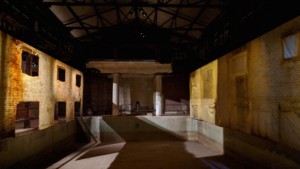In slow motion, lightweight forms descend from above to greet visitors to the opening of Slow Dialogues: Time, Space, and Scale at Yerba Buena Center for the Arts (YBCA) in San Francisco.
Black-clad dancers grasp and tangle with the pliable and dynamic forms, opening them up, spreading them across the floor, nimbly interacting, transforming, and reforming the woven bamboo structures. These pieces featured in the group exhibit, Traveling Geometry (2008–16), are the work of Dutch designer Maria Blaisse. Blaisse’s current work carves out the space between architecture, sculpture, and performance, a unique amalgamation of simple materials, complex forms, and a sensitive awareness of balance and flow. As part of the larger exhibition’s themes, Blaisse’s work investigates the movement of both the forms within the larger space of YBCA and its specific location in the upstairs exhibition by curator Carolyn Strauss, who organized this group show under the auspices of her Slow Research Lab, a Netherlands-based, multi-disciplinary research and curatorial platform.
Megumi Matsubara’s It Is a Garden (2016), a site-specific piece developed exclusively for this exhibition and the YBCA, slowly and quietly proposes a meditative response to the Yerba Buena Gardens where the center is located. Her collection of photographs of local flora and mirrors reflect both visitors and the interior space of the building. Matsubara’s piece harkens back to Robert Smithson’s Photoworks and engages the flexible upstairs corridor and main atrium space designed by Fumihiko Maki in a shifting context that involves both the spectator and the architecture in a new and original way of seeing. Through the doubling action of the mirror, the bystander and the surrounding space enter into a larger dialogue that slowly shifts between dimensions, while the precisely-detailed, macro photographs of local flowers reinforce location, reminding the visitor of the soft, magical garden surrounding the hard walls and geometric architecture of the YBCA.
The final part of the group show is a spectacular latex cast of the old United States Mint created by Jorge Otero-Pailos as part of his ongoing series The Ethics of Dust. Layers upon layers of latex are actively gathered by Otero-Pailos’s team as they extract the actual dirt and dust that has accumulated over time on the mint—materials that have become a part of the makeup and history of the building. What would normally be thought of as the opponent in the preservation process—the visible and unwanted pollution and grime of the building—becomes a thickened, draped, semi-translucent form echoing the multidimensional themes of the exhibit in phenomenological and poetic harmonies. Visitors pass between these “newly” hung walls of the existing building, walls that have been translated and dispossessed of their physicality. Somewhere in the middle of painting, installation, and architecture, this series of experimental preservation artifacts is able to capture an unspoken essence, an architectural potential, and an environmental actuality with a deft hand and an elegant spirit of means and materiality. By cleaning the walls in this profoundly contrasting style to how traditional conservation would act to erase the traces of dirt, the passage of time and pollution are able to reveal an intrinsic truth concerning the aging process of buildings, allowing the copy, both interpretation and original, to move to the forefront.
Overall, Slow Dialogues: Time, Space, and Scale engages the viewer in contemporary conversations regarding the blurred lines between the disciplines of art and architecture in expressive and inspired moments of tension caught between the poetry of action and inaction, invisible and accumulated experiences, moments of human profundity and nature’s ability to mark and trace man’s perilous attempt to create meaning. Each protagonist in this exhibit is able to comment upon the universal themes of time, space, and scale in unique and specific ways marked upon by its individual style and ethos. As individuals they work at the boundaries and extremities of these disciplines, somewhat unknown voyagers chasing meaning and conventions to produce novel bodies of creation, integrating and investigating extraordinary themes through familiar yet destabilized versions of the what could be thought of as the original.









